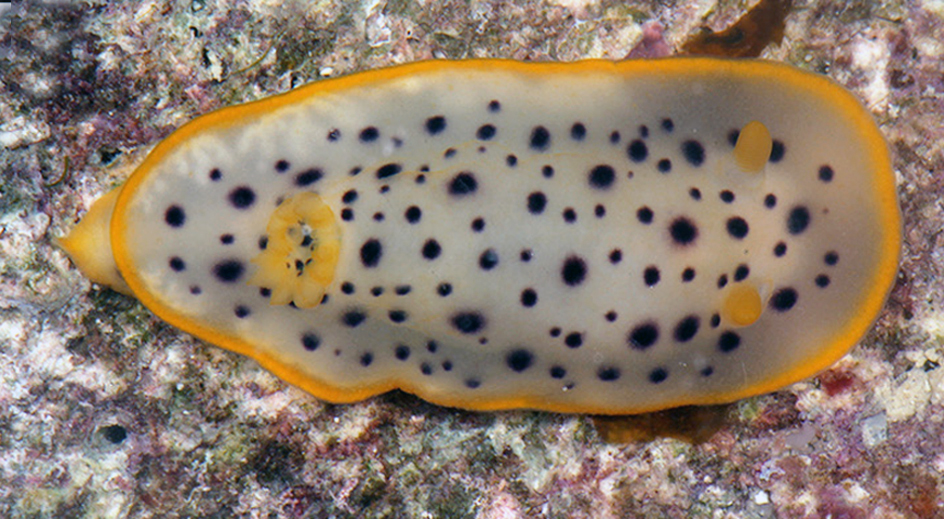 |
Image courtesy of Dr. Terry Gosliner
Red Sea
Chromodoris baqe Bonomo & Gosliner, 2020
Another new Chromodoris this week again described by Lynn Bonomo and Terry Gosliner.
Lynn and Terry explain that the name Chromodoris baqe comes from the Arabic word for spots, since the entire nudibranch is covered in black spots and looks similar to a cow. Chromodoris baqe is listed as Chromodoris sp. 18 in NSSI 2nd Edition (page 141), among the other spotted chromodorids.
Living animals are relatively large, with a maximum length of 25 mm. The body is cream-white with different sized spots that cover the entire mantle and foot. The larger spots are dark purple and diffuse outwards, while the smaller spots are solid dark purple in color. The marginal band is orange and surrounds the entire mantle and visible portion of the foot. The gill branches are a solid yellowish cream to orange in color. The perfoliate rhinophores are orange. The posterior end of the foot extends well past the posterior end of the mantle and is ornamented the same as the mantle.
Chromodoris baqe is most similar to Chromodoris aspersa (Gould, 1852)(Courtesy of Bill Rudman's Sea Slug Forum), from the Indo-Pacific. There are several distinct external characters that clearly distinguish the two species. First and foremost, the body of C. baqe is ovoid with a significant overhang of the mantle over the lateral edges of the foot, whereas C. aspersa is long and narrow with the edge of the mantle does not extend much beyond the lateral edge. The general body color of C. baqe is a cream color as compared to the translucent white color of C. aspersa. The dark purple spots of C. baqe are larger, slightly raised, and diffuse, whereas they are smaller with a faint purple ring in C. aspersa that almost make the spots appear out of focus.
Contrary to the photos shown in NSSI 2nd edition (page 141) the authors report that, spots are present on the posterior end of the foot of C. baqe, whereas spots are entirely absent on the posterior foot in C. aspersa. Hummm. I guess we will have to work on that.
This species is only known from the Red Sea.
Reference:
LYNN J. BONOMO & TERRENCE M. GOSLINER. 2020. Adding stars to the Chromodoris (Nudibranchia, Chromodorididae) galaxy with the description of four new species. Zootaxa 4819 (3): 401-435.
Dave Behrens
Sammamish, WA 98074
Jan., 2021
Send Dave email at davidwbehrens@gmail.com

|
